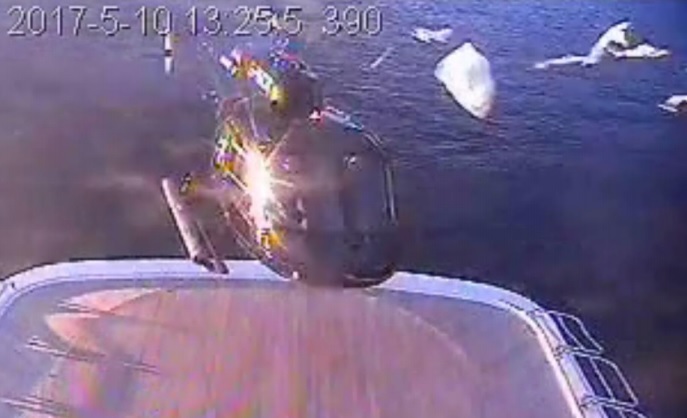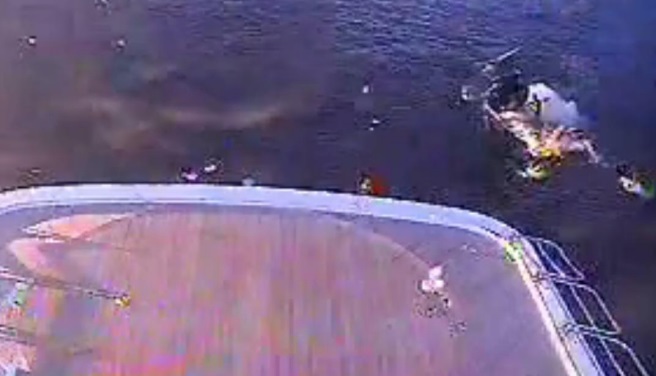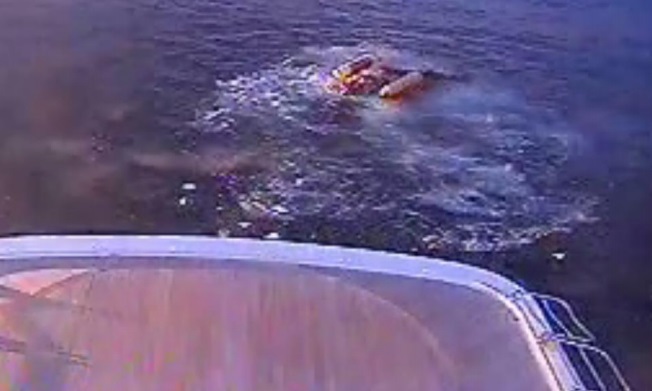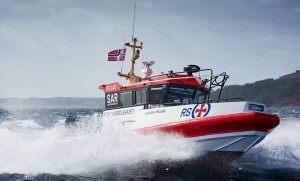FOD and an AS350B3 Accident Landing on a Yacht in Bergen
On 10 May 2017 Airbus Helicopters AS350B3 G-HKCN of HQ Aviation crashed into the sea while attempting to land on the 60m motor yacht Bacarella outside Bergen harbour in Norway during a private flight. All three persons on board egressed the helicopter. One passenger was transported to hospital.
UPDATE 12 February 2019: The Accident Investigation Board Norway (AIBN – the Statens Havarikommisjon for Transport [SHT] in Norwegian) issued their final report.
The helicopter had flown to Norway that day from the UK. The helicopter landed at Bergen Airport for refuelling where all three on board took off their survival suits and life jackets. The investigators explain that:
The commander had valid British ATPL(H) with type rating for AS350B3 and flight instructor privileges. The person piloting the helicopter had a PPL(H), but no type rating for the helicopter type. He had had performed his skill test on AS350B3 the day before the accident. It was his first attempt to land an AS350B3 on the helideck. Landing on a helideck was not a part of any formal flight training programme. Thus, this was not a flight that formally required an instructor.
As the helicopter approached the helideck on the yacht, it stopped in low hover over the helideck for approximately 15 seconds [then] a tarpaulin covering a jet fuel bowser located forward on the helideck detached and was blown up in the main rotor. The commander grabbed the controls and attempted to manoeuvre the helicopter aft and to the left to avoid the tarpaulin, which was on its way to blow into the main rotor due to the rotor downdraft. He did not have time to make a difference before the tarpaulin caused considerable damage to the main rotor when it encountered the rotor blades and was ripped to shreds.
The damages to the main rotor caused significant vibrations in the helicopter. The commander lost control of the helicopter after the tarpaulin struck the main rotor.
During this phase, both the commander and the pilot in the right hand seat had their hands on the controls. The helicopter ended up in the sea somewhat aft and port (left hand side) of the yacht with tail first and quickly tilted over to the right, before it came to rest upside-down.
[The helicopter] remained floating upside-down.
The commander, seated in the left hand seat, was able to quickly evacuate through the left door. Having exited the helicopter, he realised that the helicopter would sink and dived into the cockpit where he was able to activate the switch to inflate the floats [there was no Automatic Float Deployment System (AFDS) fitted].
The passenger in the rear seat was able to evacuate without assistance. The commander dived into the helicopter once more and assisted the pilot in the right hand seat to evacuate. It was this person that piloted the helicopter when the tarpaulin hit the main rotor. All three made their way up on the belly of the floating helicopter.
The Norwegian Society for Sea Rescue 13m rescue craft Bjarne Kyrkjebø was coincidentally near-by and was able to make a quick rescue of the three people onboard the helicopter. One person is reported to have serious injuries and two had minor injuries.
A video from shore is online.
The helicopter was equipped with a Appareo Vision 1000 cockpit video and data recorder.
This was “greatly beneficial in the investigation” say the AIBN.
The Appareo 1000 video recording shows that the tarpaulin was inflated by the pulsating rotor blade downwash pressure from the hovering helicopter.
The aft seat was equipped with three-point seat belts, but the passenger was not using one. He was busy filming the approach on his mobile phone. Just before the helicopter hit the water, he was thrown sideways, then forward and over the pedestal and the right hand collective stick.
The investigators note that:
There were multiple items of unsecured luggage in the cabin. In addition, there were multiple electronic devices with unsecured charging cables connected to power outlets.
Nobody on board the helicopter were using life jackets during the flight from Bergen airport to M/Y Bacarella.
The AIBN comment that:
AIBN is of the opinion that a proper risk assessment would most likely have resulted in the commander performing the landing himself. This would probably have shortened the time in hover and reduced the risk of the tarpaulin blowing off the fuel bowser.
AIBN believes that the commander made extraordinary efforts to save lives once the accident had occurred. First by diving down to activate the emergency floatation gear switch, which prevented the helicopter from sinking, and then diving down a second time to retrieve the person who was unable to evacuate on his own
The Vessel M/Y Bacarella
The Cayman Island-registered superyacht Bacarella was built in 2009 and can accommodate up to 10 guests and eight crew.

The 60m Trinity superyacht Bacarella – the deck area with sun loungers can be cleared to give a limited landing area (Credit: Unknown)
M/Y Bacarella had a helideck designed with foldable railings, pennant pole and aft lantern. The yacht’s Helicopter Operations Manual did not refer to the actual AS350 helicopter type, it only referred to operations with Robinson R44 and R66 helicopters. The helicopter’s weight created a significantly larger downdraft effect than a R44 or R66 would have done.
The helideck on M/Y Bacarella was designed to have the opportunity to land and take off without stopping the helicopters engine. The helideck had a marked circular area which the helicopter should land within. The helicopter’s tail section would then stick out aft of the helideck. The purpose of the marked circle was to indicate a landing zone which gave safe distance between the helicopter’s main rotor and structures on the yacht.
As the yacht was not in commercial operation this landing area did not need to be certified.
The yacht was not originally equipped with a fuel bowser for refuelling of helicopters. During the planned trip along the Norwegian coast, the intention was to use the helicopter for sightseeing from the yacht. For this purpose, a fuel bowser with a capacity of approximately 900 litres was placed on the helideck. It was decided to make a tarpaulin prepared to cover the fuel bowser. The tarpaulin was produced in 680g/m2 PVC-coated polyester cloth and was sewn according to specification given by the yacht’s crew. Eyelets were affixed to make it possible to lash the tarpaulin to the fuel bowser. The tarpaulin had a tight fit over the bowser’s frame and was not lashed down when accident occurred. Refuelling of helicopters on board was not described in the yacht’s Helicopter Operations Manual.
On the day of the accident…
…the yacht was not allowed by the port authorities to receive the helicopter at quay, and therefore positioned itself in the harbour without anchoring. Wind speed was 3-4 knots and the sea was calm.
The yacht’s master explained that he felt pressed for time to prepare the ship for the helicopter landing. He accepted to rush the preparation. As a result, several issues in the Helicopter Operations Manual were omitted. The fire fighting equipment was not prepared for use on the helideck, and a safety tender was not set out. The custom made tarpaulin covering the jet fuel bowser was not lashed down using the affixed eyelets. The tarpaulin’s fit around the fuel bowser’s frame was so tight that lashing was considered necessary only in windy conditions and when in open waters. The cruise was to be in coastal waters.
The first mate…stated he had received a superficial brief on helicopter operations by the former first mate without any reference to the yacht’s Helicopter Operations Manual.
According to the master’s explanation, he monitored the landing from the bridge with the aid of a surveillance camera (CCTV). The first mate was new on board the yacht, and this was his first helideck operation. He was supposed to act as “Helideck Landing Officer” (HLO). The first mate was standing inside glass doors forward of the helideck to monitor the landing. Both the master and the first mate communicated with the helicopter. The first mate notified the master that everything was ready, and the master cleared the helicopter for landing
The AIBN finds it positive that a Helicopter Operations Manual existed. At the same time, it appears as if the manual was not in use. The lack of adherence to multiple requirements and procedures indicates that the manual was a passive document. Incomplete preparation of the yacht would have mandated the master’s denial of landing the helicopter if the manual’s procedures had been followed.
The AIBN have not made any safety recommendations.
There was a subsequent civil court case.
Safety Observations
This accident highlights the importance of FOD control on vessels expecting helicopters for hoisting or landing.
In 2013 NTSB issued a safety alert: Helicopter Landing Sites: Free from Debris (SA-57). BP has shared a video on the threat of downwash (albeit with larger helicopters):
Another case of FOD occurred on the Northern Lighthouse Board (NLB) lighthouse tender NLV Fingal on 30 June 1991 involving Bond Bolkow Bo-105D, G-BTBD. The AAIB reported that a large a canvas sheet covering stores on the deck impacted the running main rotor.
Other Helideck Safety Resources
- Helideck Safety Alerts: Refuelling Hoses and Obstructions
- NTSB Recommendations on Offshore Gas Venting
- Mind the Handrail! – Walk-to-Work Helideck Hazard
- Passive Fire-Retarding Helideck Designs
- US BSEE Helideck A-NPR / Bell 430 Tail Strike
- Troublesome Tiedowns
- Helideck and Helicopter Egress Training Facilities
- Wrong Deck Landings
- UPDATE 8 September 2020: Air Ambulance Helicopter Downed by Fencing FOD
- UPDATE 20 September 2020: Hanging on the Telephone… HEMS Wirestrike
- UPDATE 16 April 2022: Helideck Heave Ho!
- UPDATE 24 September 2022: Fire Extinguisher Cover Fenestron FOD
Aerossurance regularly assists oil and gas companies and vessel operators review and update their helideck procedures and adverse weather policies, examine helideck structural integrity issues and provide independent assurance of helideck readiness.








Recent Comments